created on May 8, 2003 - JLN Labs - Last update March 22, 2006
Toutes les informations et schémas sont publiés gratuitement ( freeware ) et sont destinés à un usage personnel et non commercial
All informations and diagrams are published freely (freeware) and are intended for a private use and a non commercial use.
Toutes les informations et schémas sont publiés gratuitement ( freeware ) et sont destinés à un usage personnel et non commercial
All informations and diagrams are published freely (freeware) and are intended for a private use and a non commercial use.
The Cold Fusion Reactor ( CFR ) is fully based on the work of the researchers Tadahiko MIZUNO and Tadayoshi OHMORI from the Hokkaido University in Japan. On May 7th, 2003, I have replicated successfully the Mizuno-Ohmori's Cold Fusion experiment. I have used the experimental protocol fully described by Eugene F. Mallove at : http://www.amasci.com/weird/anode.txt,
Today, I can say that the Mizuno-Ohomori's Cold Fusion Reactor is fully replicable and that it works very well as described in their papers. You will find below the latest measurements results that I have performed since the May 7th, 2003 :

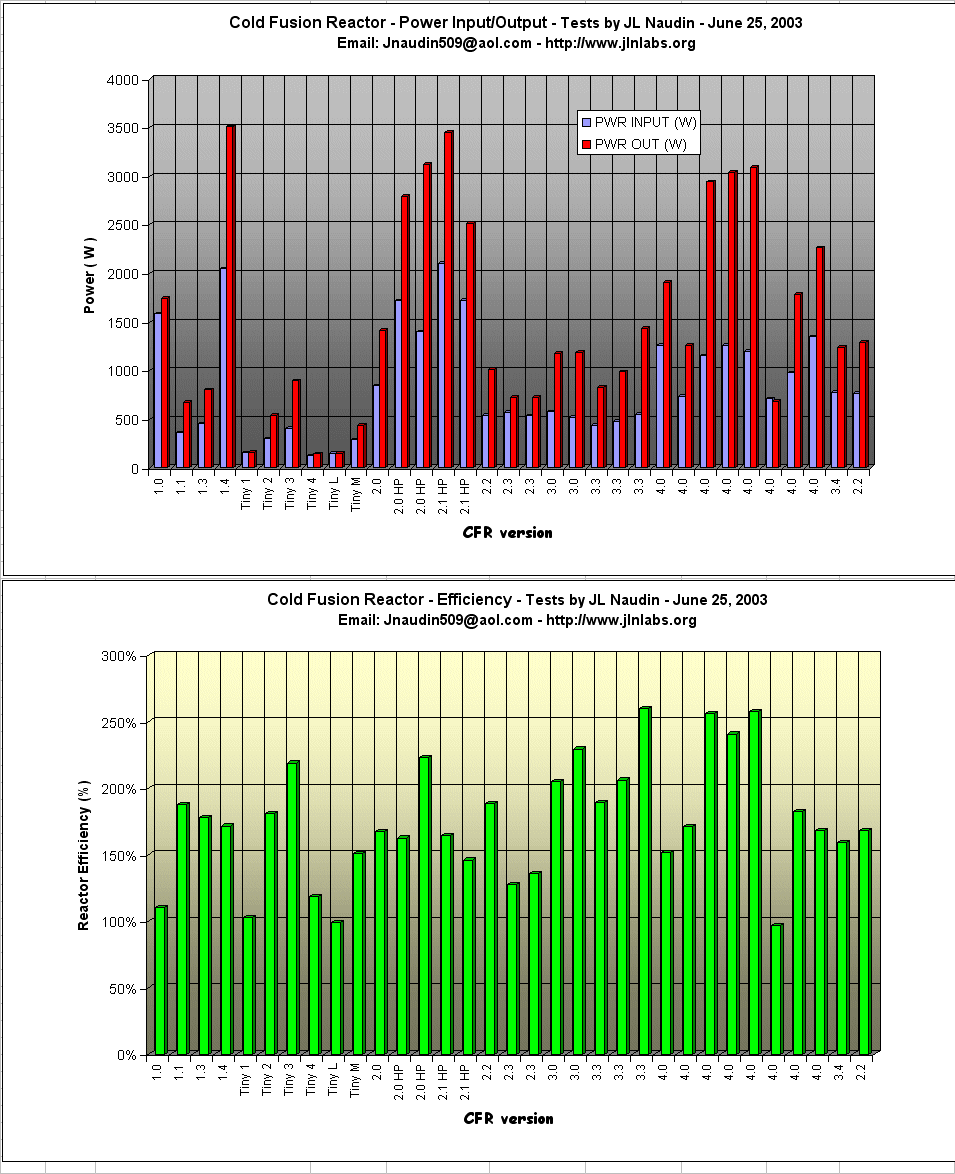
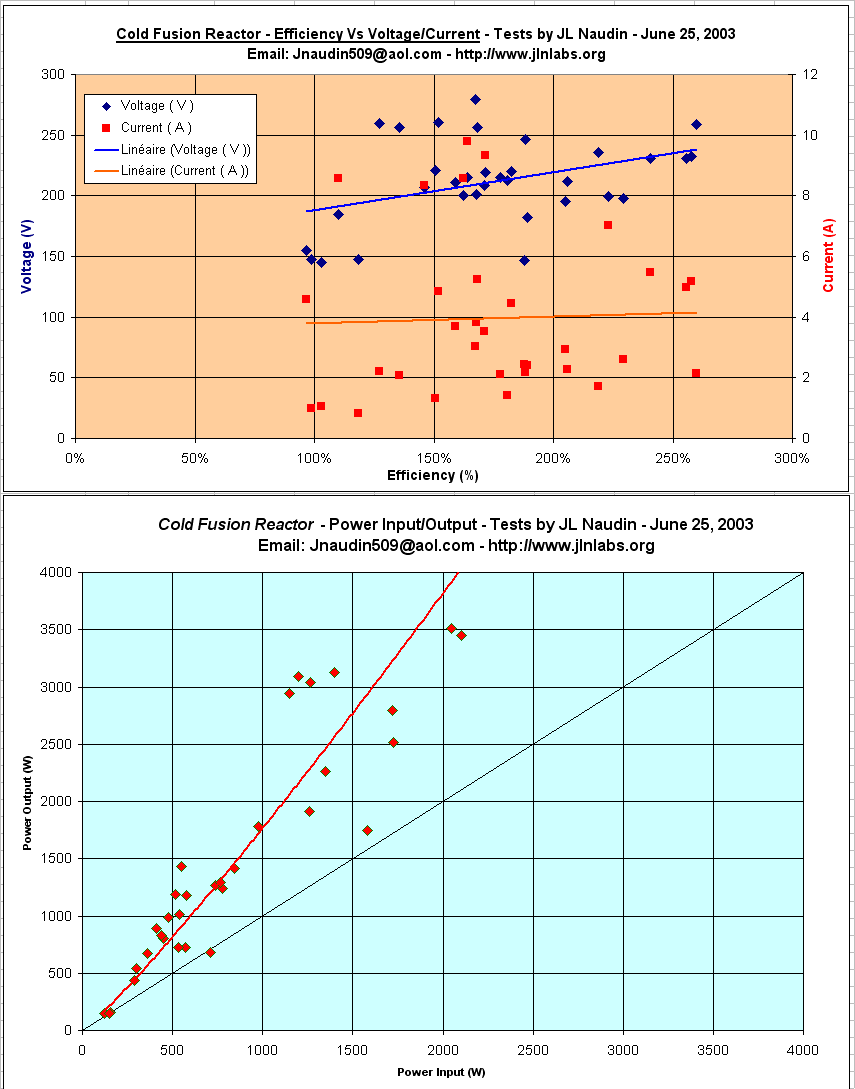
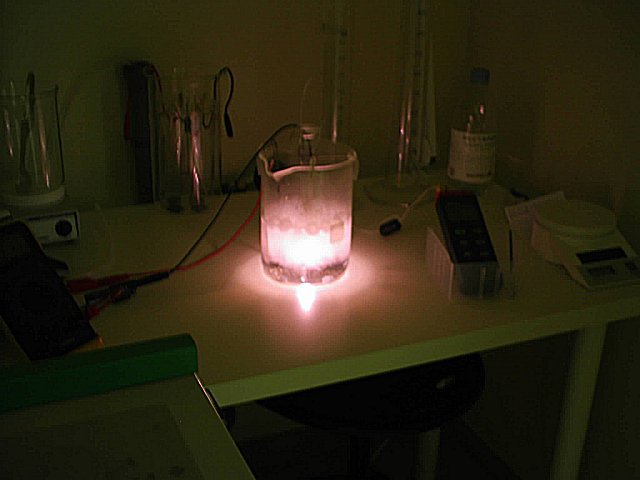
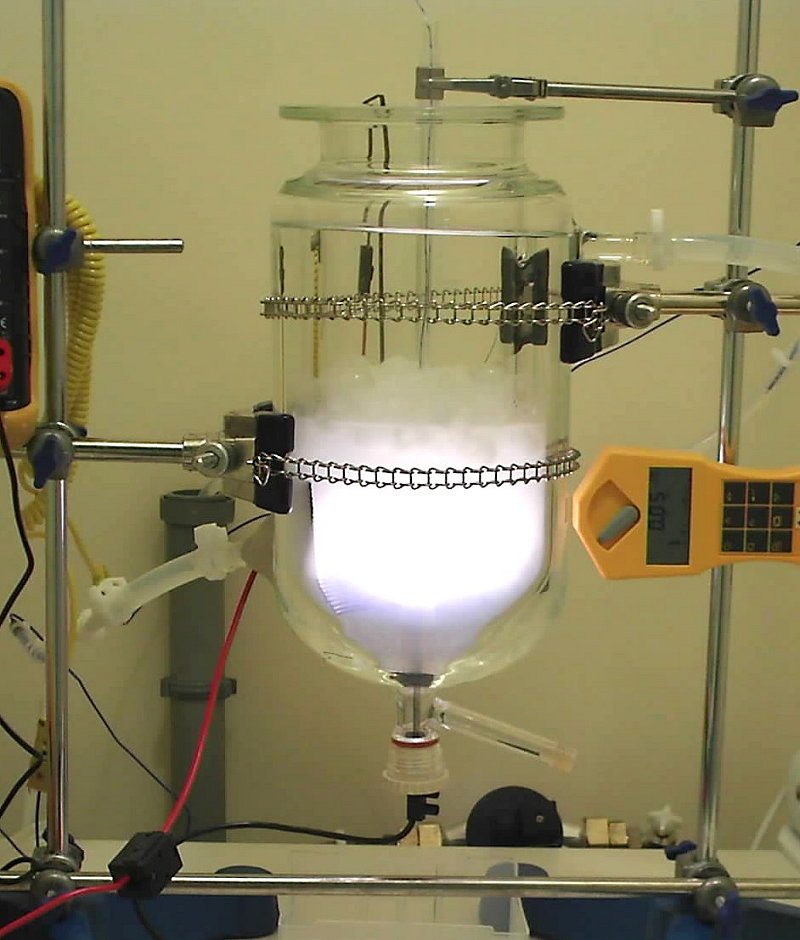

The Mizuno's CFR experiment is fully detailled in the papers :
Production of Heat During Plasma Electrolysis. Mizuno, T., et al - Jpn. J. Appl. Phys. A, 2000. 39: p. 6055
Production of Heat During Plasma Electrolysis. Mizuno, T., et al - Jpn. J. Appl. Phys. A, 2000. 39: p. 6055
<< Abstract:
Plasma was formed on the surface of an electrode in a liquid solution when metal cathodes underwent high-voltage electrolysis. A real-time heat calibration system was designed for detecting the amount of heat generated during plasma electrolysis. The measured heat exceeded the input power substantially, and in some cases 200% of the input power. The heat generation process depended on the conditions for electrolysis. There was no excess heat at the beginning of plasma electrolysis. However, after plasma electrolysis for a long time, a large amount of heat was generated. The reproducibility would be 100% if all factors such as temperature, voltage and duration were optimized. Based on the heat and the products, we hypothesize that some unique reaction occurs on the cathode surface. This reaction may not occur at energy levels available during electrochemical electrolysis. >>
This paper can be downloaded at the web site of the Japanese Journal of Applied Physics, http://jjap.ipap.jp/online/. Anyone can register and download papers there at no cost. http://jjap.ipap.jp/journal/pdf/JJAP-39-10R/6055.pdf
Confirmation of anomalous hydrogen generation by plasma electrolysis. Mizuno, T., T. Akimoto, and T. Ohmori. in 4th Meeting of Japan CF Research Society. 2003. Iwate, Japan: Iwate University.
<< Abstract:
Direct decomposition of water is very difficult in normal conditions. Hydrogen gas is usually obtained by the electrolysis. Pyrolysis decomposition of water occurs at high temperatures, starting at ~3000ºC. As we have already reported, anomalous hydrogen is sometimes generated during plasma electrolysis. Excess hydrogen usually appears once certain difficult conditions during high temperature glow discharge electrolysis are met. Here, we show that anomalous amounts of hydrogen and oxygen gas are generated during plasma electrolysis excess gas generation, presumably from pyrolysis. This is indirect proof that exceptionally high temperatures have been achieved. (Direct measurement of the reaction temperature has proved difficult.) Continuous generation of hydrogen above levels predicted by Faraday’s law is observed when temperature, current density, input voltage and electrode surface meet certain conditions. Although only a few observations of excess hydrogen gas production have been made, production is sometimes 80 times higher than normal Faradic electrolysis gas production. >>
This paper can be downloaded at : http://www.lenr-canr.org/acrobat/MizunoTgeneration.pdf
<< No one has patents or may be able to get them since the effect was noticed in other forms (1916!) and reported extensively in the Journal of the Electrochemical Society, April, 1950, p.133 in an article titled ("The Anode Effect in Aqueous Electrolysis," by Herbert Kellogg of the School of Mines, Columbia University. New York >> has said Eugene F. Mallove...
Interesting documents and references :
- Mizuno, T., et al., Production of Heat During Plasma Electrolysis. Jpn. J. Appl. Phys. A, 2000. 39: p. 6055.
- Mizuno, T., T. Akimoto, and T. Ohmori. Confirmation of anomalous hydrogen generation by plasma electrolysis. in 4th Meeting of Japan CF Research Society. 2003. Iwate, Japan: Iwate University.
- Infinite Energy Vol.4, No20, 1998
- Mizuno, T., Nuclear Transmutation: The Reality of Cold Fusion. 1998, Concord, NH: Infinite Energy Press.
- Mizuno, T. Experimental Confirmation of the Nuclear Reaction at Low Energy Caused by Electrolysis in the Electrolyte. in Proceedings for the Symposium on Advanced Research in Energy Technology 2000. 2000. Hokkaido University.
- COLD FUSION BY PLASMA ELECTROLYSIS OF WATER by Ph.M. Kanarev - The Kuban State Agrarian University, Department of Theoretical Mechanics.
- Ph.M. Kanarev. Water is New Source of Energy. The Third Edition. Krasnodar 2002.194p
- The LENR-CANR home page
- Full downloadable PDF documents about Cold Fusion researches at the LEN-CANR web site
- The Atomic Hydrogen blowtorch invented by Irwing Langmuir in 1926
- Anomalous Heat from Atomic Hydrogen in contact with potassium carbonate by R. M. Shaubach and N.J. Gernert from Thermacore, Inc
PATENT : WO0025320 : " Energy Generation " from Eccles Christopher Robert ( GB ) - May 4, 2000Abstact :
Methods and apparatus are described for releasing energy from hydrogen and/or deuterium atoms. An electrolyte is provided which has a catalyst therein suitable for initiating transitions of hydrogen and/or deuterium atoms in the electrolyte to a subground energy state. A plasma discharge is generated in the electrolyte to release energy by fusing the atoms together.
 Click here to download the Full Patent
Click here to download the Full Patent
PATENTS from MIZUNO TADAHIKO (JP) : - WO0126117 - THERMAL ENERGY EXTRACTION APPARATUS, HOT-WATER SUPPLY, AND ELECTRIC GENERATOR - April 12, 2001Abstact : A thermal energy extraction apparatus comprises an electrolyte bath (1), electrolytic solution (4), electrodes (2, 3), an atomic nuclear fission means (11), and a thermal energy extraction means (5, 6a, 6b, 13a-13e, 14, 23a, 23b). The electrolytic solution (4) is kept inside the electrolyte bath (1) and contains at least light water or heavy water. The electrodes (2, 3) are so arranged as to be in contact with the electrolytic solution (4) and include an anode (3) and a cathode (3). The atomic nuclear fission means (11) fissions atomic nuclei of the material constituting the electrodes (2, 3) by applying a voltage and a current to the electrodes (2, 3). The thermal energy extraction means (5, 6a, 6b, 13a-13e, 14, 23a, 23b) extracts heat medium (18, 19, 21, 22a, 22b) heated by the thermal energy generated by the fission of the atomic nuclei of the material constituting the electrodes (2, 3) to the outside of the electrolyte bath (1).
Click here to download the Full Patent
- WO9949471 - REACTOR FOR PRODUCING ENERGY AND NEUTRONS BY ELECTROLYTIC REACTION IN LIGHT- OR HEAVY-WATER SOLUTION - September 30, 1999Abstact : A reactor for producing energy and neutrons by electrolytic reaction in a light- or heavy-water solution comprises a base made of a refractory metal and a metal layer formed on the base and active against hydrogen. The reactor to serve as a cathode is immersed in an electrolyte together with an anode. Current is made to flow between the cathode and anode to cause an electrolytic reaction. Thus, thermal energy and neutrons are produced.
Click here to download the Full Patent
- JP5027062 : GENERATION OF ABNORMAL HEAT- February 5, 1993
- WO0126117 - THERMAL ENERGY EXTRACTION APPARATUS, HOT-WATER SUPPLY, AND ELECTRIC GENERATOR - April 12, 2001Abstact : A thermal energy extraction apparatus comprises an electrolyte bath (1), electrolytic solution (4), electrodes (2, 3), an atomic nuclear fission means (11), and a thermal energy extraction means (5, 6a, 6b, 13a-13e, 14, 23a, 23b). The electrolytic solution (4) is kept inside the electrolyte bath (1) and contains at least light water or heavy water. The electrodes (2, 3) are so arranged as to be in contact with the electrolytic solution (4) and include an anode (3) and a cathode (3). The atomic nuclear fission means (11) fissions atomic nuclei of the material constituting the electrodes (2, 3) by applying a voltage and a current to the electrodes (2, 3). The thermal energy extraction means (5, 6a, 6b, 13a-13e, 14, 23a, 23b) extracts heat medium (18, 19, 21, 22a, 22b) heated by the thermal energy generated by the fission of the atomic nuclei of the material constituting the electrodes (2, 3) to the outside of the electrolyte bath (1).
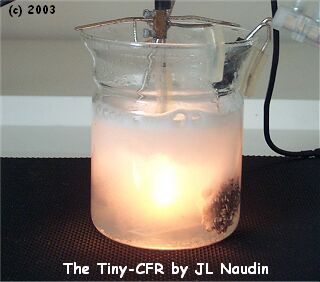


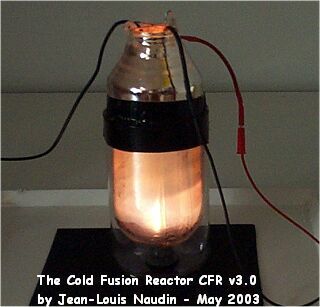
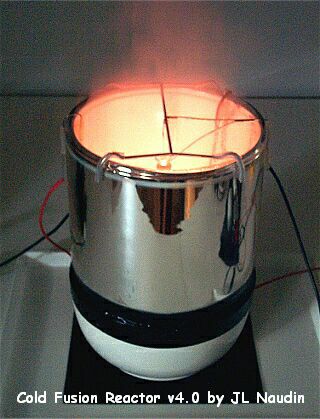




0 komentar:
Posting Komentar
Barokallah . .